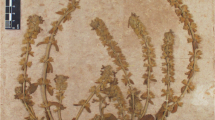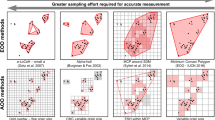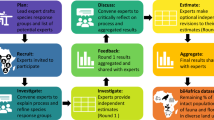Abstract
Red Lists are widely used to indicate species at risk of extinction. Specimen sheets in herbaria provide an important source of data relevant for Red List assessments. The aims of this paper are to establish which data can be sourced from specimen information to satisfy IUCN Red Data List criteria and to identify the specific criteria that can be used. Red List parameters are measured within a Geographical Information System (GIS), as this provides an objective and repeatable methodology which is less subjective than manual methods. Data used to explore this were gathered during the course of preparing a monograph on Plectranthus (Lamiaceae). Criteria relating to distribution (extent of occurrence, area of occupancy and fragmentation) and population profile (projected continuing decline and number of subpopulations) proved most suitable for assigning categories of threat. Estimates of mature individuals, generation length, population size, population reduction, extreme fluctuation and number of locations could not be derived from herbarium material without making inconsistent subjective decisions. In addition to comprehensively databased specimen information, extensive field knowledge is required to produce better estimates for assessing extinction risk. In order to enhance the usefulness of specimen information in the future, improvements in recording additional botanical data at the time of collection would be beneficial. Overall, herbaria provide a useful starting point for conservation-related work and can help to guide future work.
Similar content being viewed by others
References
Akçakaya R. and Ferson S. 1999. RAMAS Red List Threatened Species Classifications Under Uncertainty. User Manual for Version 1.0, Applied Biomathematics, Setauket, New York.
Botanic Gardens Conservation International 2000. The Gran Canaria Declaration: Calling for a Global Program for Plant Conservation. Botanic Gardens Conservation International, Richmond, California.
Burgman M., Maslin B.R., Andrewartha D., Keatley M.R., Boek C. and McCarthy M. 2000. Inferring threat from scientific collections. In: Ferson S. and Burgman M. (eds), Quantitative Methods for Conservation Biology. Springer-Verlag, New York, pp. 7–26.
ESRI 1996. ArcAtlas™: Our Earth. Environmental Systems Research Institute, Redlands, California.
ESRI 1997. World Agricultural Threat to the Environment. http://www.geographynetwork.com.
ESRI 1999. Arcview GIS™.
Gärdenfors U. 2001. Classifying threatened species at national versus global levels. Trends in Ecology and Evolution 16: 511–516.
Golding J.S. 2001. Southern African herbaria and Red Data Lists. Taxon 50: 593–602.
Golding J.S. 2002. Southern African Plant Red Data Lists Southern African Botanical Diversity Network Report Series Number 14, Pretoria, South Africa..
Golding J.S. and Smith P.P. 2001. A 13–point flora strategy to meet conservation challenges. Taxon 50: 475–478.
Hilton-Taylor C. (Compiler) 2000. IUCN Red List of Threatened Species. IUCN, Gland, Switzerland
Holmgren P. 1990. Index Herbariorum. 8th edn. New York Botanical Garden, http://www.nybg.org/bsci/ih/.
IUCN 1994. IUCN Red List Categories, prepared by the IUCN Species Survival Commission. IUCN, Gland, Switzerland.
IUCN Species Survival Commission 2000a. Habitat Types Authority File. http://www.redlist.org / habitat-types.html.
IUCN Species Survival Commission 2000b. 2000 Red List of Threatened Species. http://www.redlist. org.
IUCN Species Survival Commission 2001. IUCN Red List CategoriesVersion 3.1. http://194.158.18.4/intranet/DocLib/Docs/IUCN973.rtf.
MacDougall A.S., Loo J.A., Clayden S.R., Goltz J.G. and Hinds H.R. 1998. Defining conservation priorities for plant taxa in southeastern New Brunswick, Canada using herbarium records. Biological Conservation 86: 325–338.
McGarigal K., Marks B. and Holmes C. 2000. Fragstats: User Guidelines v. 3. Department of Natural Resources Conservation, University of Massachusetts, http://www.unix.oit.umass.edu/fragstat.
Oldfield S., Lusty C. and McKinven A. 1998.World List of Threatened Trees.World Conservation Press, Cambridge, UK, http://www.wcmc.org.uk/trees/Background/intro.htm.
Olson J.S. 1994. Global ecosystem framework – definitions. USGS EROS Data Center, Sioux Falls, South Dakota, Internal Report.
Rempel R. 2000. Patch Analyst 2.2©& Patch Analyst Grid 2.1. Sustainable Forest Management Network (NCE) with support from the Centre for Northern Forest Ecosystem Research. http:flash.lakeheadu.ca. / rrempel/patch/.
Rapoport E.H. 1982. Areography: Geographical Strategies of Species. Pergamon Press, New York.
Schatz G.E., Birkinshaw C., Lowry II P.P., Randriantafika F. and Ratovoson F. 2000. The Endemic Plant Families of Madagascar Project: Integrating Taxonomy and Conservation. In: Lourenço W.R. and Goodman S.M. (eds), Diversité et Endémisme à Madagascar. Mémoires de la Societé de Biogéophie, Paris.
Secretariat for the Convention on Biological Diversity 2002. Decisons adopted by the Conference of Parties to the Convention on Biological Diversity at its Sixth Meeting. The Hague, 7–19 April 2002. Global Strategy for Plant Conservation, pp.73–85. http://www.biodiv.org/doc/decisions/cop-06–dec-en.pdf.
Ter Steege H., Jansen-Jacobs M.J. and Datadin V.K. 2000. Can botanical collections assist in a National Protected Area Strategy in Guyana? Biodiversity and Conservation 9: 215–240.
United States Board on Geographic Name uses database 2003. http://gnpswww.nima.mil/geonames/GNS
USGS-NASA Distributed Active Archive Center 2000. Global Land Cover Characteristics Datasets. http://edcdaac.usgs.gov/glcc/globdoc2–0.htm.
Author information
Authors and Affiliations
Corresponding author
Rights and permissions
About this article
Cite this article
Willis, F., Moat, J. & Paton, A. Defining a role for herbarium data in Red List assessments: a case study of Plectranthus from eastern and southern tropical Africa. Biodiversity and Conservation 12, 1537–1552 (2003). https://doi.org/10.1023/A:1023679329093
Issue Date:
DOI: https://doi.org/10.1023/A:1023679329093




